Total 61 Questions
Last Updated On : 15-Dec-2025
Preparing with Marketing-Cloud-Intelligence practice test is essential to ensure success on the exam. This Salesforce allows you to familiarize yourself with the Marketing-Cloud-Intelligence exam questions format and identify your strengths and weaknesses. By practicing thoroughly, you can maximize your chances of passing the Salesforce certification 2025 exam on your first attempt. Surveys from different platforms and user-reported pass rates suggest Marketing Cloud Intelligence Accredited Professional practice exam users are ~30-40% more likely to pass.
Your client would like to create a new harmonization field - Exam Topic.
The below table represents the harmonization logic from each source.
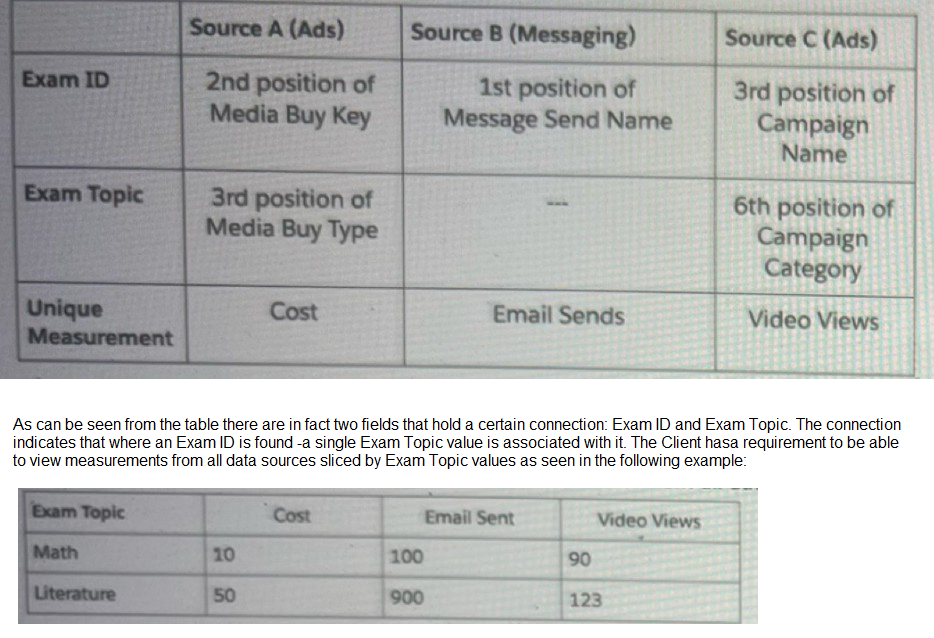
Which harmonization feature should an Implementation engineer use to meet the client's requirement?
A. Transformers
B. Parent Chile
C. Fusion
D. Custom Classification
E. Calculated dimensions
Explanation:
Why D is Correct:
A Custom Classification in Marketing Cloud Intelligence is specifically designed for this purpose. It allows you to map multiple, disparate values from different source fields into a single, unified dimension (a "harmonized field").
In this case, you have three different sources, each with a different field containing values for "Exam Topic":
Source A: 3rd position of Media Buy Type
Source B: (No direct field, implied to be derived from another value)
Source C: 6th position of Campaign Category
You would create a new Custom Classification dimension called "Exam Topic". Within its settings, you define rules to map the values from these three different source fields into the new, common set of values (e.g., "Math", "Literature"). This creates a single dimension that can be used across all widgets to slice the metrics Cost, Email Sends, and Video Views, exactly as shown in the client's desired output table.
Why the Other Options are Incorrect:
A. Transformers:
Transformers are used for data cleansing and manipulation within a single data source (e.g., changing text to lowercase, splitting fields, formatting dates). They are not used to create a new, unified dimension by combining values from multiple independent data sources.
B. Parent-Child:
Parent-Child is a data modeling relationship used to create a hierarchy between two related dimensions from the same data source (e.g., Country -> State -> City). It is not used to harmonize different fields from different sources into a single new dimension.
C. Fusion:
Fusion is a feature that combines metrics from different data sources into a single, new calculated metric (e.g., Total Conversions = Facebook Conversions + Google Ads Conversions). It works with metrics, not with creating new unified dimensions for slicing data.
E. Calculated Dimensions:
Calculated dimensions are created using functions and logic applied to existing fields within a single data source (e.g., CONCAT(FirstName, " ", LastName)). They cannot pull values from fields that exist in separate, unrelated data sources to create a harmonized field.
Reference:
This solution directly addresses the core objective of the Marketing Cloud Intelligence platform: to unify fragmented marketing data. The Custom Classification feature is the primary tool for achieving dimensional harmonization across multiple data connectors, a fundamental concept for the AP-215 exam.
Which two statements are correct regarding variable Dimensions in marketing Cloud intelligence’s data model?
A. These dimensions are stored at the workspace level
B. Variable Dimensions hold a Many-to-Many relationship with its main entity
C. All variables exist in every data set type, hence are considered as overarching dimensions
D. These are stand alone dimensions that pertain to the data set itself rather than to a specific entity
Explanation:
A. These dimensions are stored at the workspace level
This statement is correct. Variable dimensions, such as geolocation data or device categories, are not specific to a single data stream's entity. Instead, they exist as standalone dimensions that can be used across the entire workspace to provide additional context to your data. This allows you to slice and dice your reports based on a dimension that isn't tied to a specific campaign, creative, or media buy.
B. Variable Dimensions hold a Many-to-Many relationship with its main entity
This statement is also correct. A variable dimension can have a many-to-many relationship with a main entity. For example, a single campaign (the main entity) might have impressions in many different cities (the variable dimension), and a single city might have impressions for many different campaigns. This is in contrast to entity attributes, which have a one-to-one or one-to-many relationship with their main entity.
C. All variables exist in every data set type, hence are considered as overarching dimensions
This statement is incorrect. While variable dimensions are broad in scope, they don't necessarily exist in every data set. They are also not automatically categorized as "overarching dimensions." Overarching dimensions are a type of classification used for high-level, global fields like Brand or Market that apply across all data, whereas variable dimensions are more granular and tied to specific attributes like Device or OS.
D. These are stand alone dimensions that pertain to the data set itself rather than to a specific entity
This statement is partially correct but not the best description. While they are indeed standalone dimensions, they don't just pertain to a "data set." Their primary purpose is to provide context to the entities and measurements within those data sets. For example, a Device Type variable dimension provides context for the Impressions measurement and the Media Buy entity. The phrasing is slightly misleading and A and B are more precise definitions of their characteristics.
An Implementation engineer is requested to create anew harmonization field 'Offer’and apply the following logic:
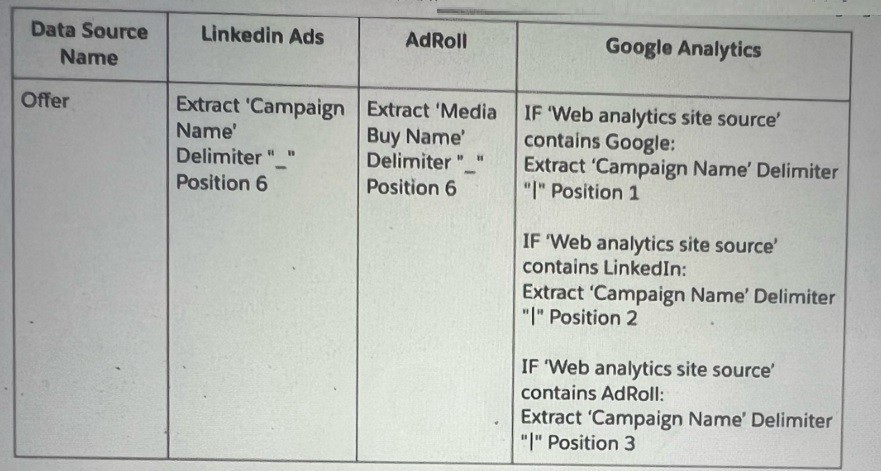
The implementation engineer to use the Harmonization Center. Which of the below actions can help implement the new dimension ‘Offer?
A. Two separate patterns (filtered by Linkedin or AdRoll sources) Within Google Analytics' mapping A formula that reflects the logic above will be populated within a Web Analytics Site custom attribute Another pattern to be created for the newly Web Analytics Site custom attribute (filtered by Google Analytics source). A total of 3 patterns.
B. Two separate patterns (filtered by Linkedin or AdRoll sources) Within Google Analytics' mapping: A formula that reflects the logic above will be populated within a Campaign custom attribute. Another pattern to be created for the newly campaign attribute (filtered by Google Analytics source). A total of 3 patterns
C. Two separate patterns (filtered by Linkedin or AdRoll sources). Another single pattern for Campaign Name (filtered by Google Analytics source). A total of 3 patterns.
D. Two separate patterns (filtered by Linkedln or AdRoll sources). Another single pattern for Web Analytics Site Source (filtered by Google Analytics source), extracting all three positions A total of 3 patterns.
Explanation:
To create a new harmonization field 'Offer' using the Harmonization Center, the Implementation engineer must ensure the logic is applied consistently across LinkedIn Ads, AdRoll, and Google Analytics sources. The table specifies:
For LinkedIn Ads, 'Offer' is extracted from 'Campaign Name' at position 6 with a "_" delimiter.
For AdRoll, 'Offer' is extracted from 'Media Buy Name' at position 6 with a "_" delimiter.
For Google Analytics, 'Offer' is extracted from 'Campaign Name' with a "|" delimiter at position 1 if the 'Web analytics site source' contains "Google," position 2 if it contains "LinkedIn," or position 3 if it contains "AdRoll."
Option B is correct because it proposes two patterns for LinkedIn and AdRoll (covering their respective 'Campaign Name' and 'Media Buy Name' fields) and a third pattern for Google Analytics. It specifies using a Campaign custom attribute in Google Analytics to apply the conditional formula (based on 'Web analytics site source'), which aligns with the logic for extracting 'Offer' from 'Campaign Name' at different positions. A new pattern for this Campaign custom attribute ensures harmonization across all sources.
A is incorrect because using a Web Analytics Site custom attribute for Google Analytics doesn’t align with the logic, which relies on 'Campaign Name' rather than a site source attribute.
C is incorrect because it only mentions a pattern for 'Campaign Name' without addressing the conditional logic or a custom attribute, missing the formula application.
D is incorrect because it suggests using 'Web Analytics Site Source' and extracting all three positions, which doesn’t match the conditional extraction logic based on the source type.
Reference:
This approach follows the harmonization process outlined in Salesforce Marketing Cloud Intelligence documentation for multi-source data mapping.
A technical architect is provided with the logic and Opportunity file shown below:
The opportunity status logic is as follows:
For the opportunity stages “Interest”, “Confirmed Interest” and “Registered”, the status should be “Open”.
For the opportunity stage “Closed”, the opportunity status should be closed Otherwise, return null for the opportunity status.
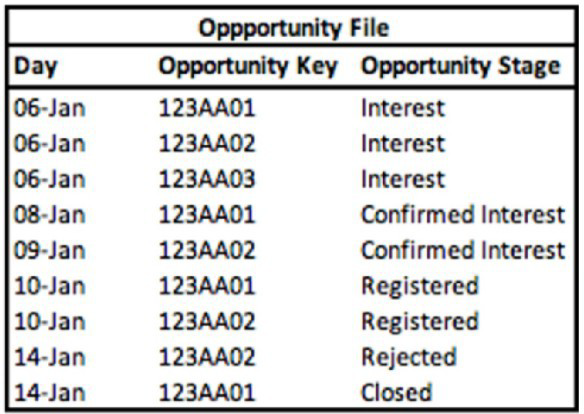
Given the above file and logic and assuming that the file is mapped in a generic data stream type with the following mapping
“Day” — Standard “Day” field
“Opportunity Key” > Main Generic Entity Key
“Opportunity Stage” + Generic Entity Key 2
A pivot table was created to present the count of opportunities in each stage. The pivot table is filtered on Jan 7th - 11th. Which option reflects the stage(s) the Opportunity key 123AA01 is associated with?
A. Registered
B. Interest & Registered
C. Confirmed Interest & Registered
D. Interest
E. Confirmed Interest
Explanation:
For Opportunity 123AA01, the records are:
06-Jan – Interest
08-Jan – Confirmed Interest
10-Jan – Registered
14-Jan – Closed
The pivot is filtered to Jan 7–11, so only 08-Jan and 10-Jan fall in range. With Opportunity Stage mapped to Generic Entity Key 2, the opportunity is counted under the stages that occur within the filter window—therefore Confirmed Interest and Registered. The Interest (06-Jan) and Closed (14-Jan) entries are outside the filter.
Which three entities and/or functions can be used in an expression when building a calculated dimension?
A. The VLOOKUP function
B. Mapped dimensions
C. The EXTRACT function
D. Calculated dimensions
E. Mapped measurements
Explanation:
In the context of Marketing Cloud Intelligence, when building a calculated dimension, you can typically use:
B. Mapped dimensions:
These are dimensions that have been brought into Marketing Cloud Intelligence through the data integration process and have been mapped to a known schema or model.
C. The EXTRACT function:
This function can be used to dynamically create dimensions by extracting values from a mapped dimension or measurement.
E. Mapped measurements:
Similar to mapped dimensions, these are quantitative data points that have been integrated into the platform and can be referenced in calculations.
Calculated dimensions (D) and the VLOOKUP function (A) are not typically used within the expression for a calculated dimension. Calculated dimensions are usually an output, not an input, and VLOOKUP is a function typically used to enrich or connect data, not within the definition of a calculated dimension itself.
What are unstable measurements?
A. Measurements for which Aggregation Settings are set as ‘Auto’ and Granularity is set as ‘None’.
B. Measurements that are set with the LIFETIME aggregation function
C. Measurements for which Aggregation Settings are set as ‘Not Auto’ and Granularity is set as ‘None’.
D. Measurements for which Aggregation Settings are set as ‘Not Auto’ and Granularity is set as ‘Not Empty’.
Explanation:
In Salesforce Marketing Cloud Intelligence, a measurement is considered unstable when:
Aggregation Settings are set to Not Auto (i.e., manual aggregation is applied),
Granularity is set to None, meaning the measurement lacks a defined time-based or entity-based grouping.
This combination causes instability because the platform cannot reliably determine how to aggregate the data across time or entities, leading to inconsistent or misleading results in dashboards and widgets.
🔍 Why the Other Options Are Incorrect:
A. Auto + None
Auto aggregation compensates for missing granularity, so the measurement remains stable.
B. LIFETIME aggregation
LIFETIME is a valid aggregation type and does not inherently cause instability.
D. Not Auto + Not Empty
This is actually a stable configuration — manual aggregation with defined granularity is acceptable.
📘 Reference:
You can find more on this in the Salesforce Help documentation on MDP Granularity in Calculated Measurements
A client wants to integrate their data within Marketing Cloud Intelligence to optimize their marketing Insights and cross-channel marketing activity analysis. Below are details regarding the different data sources and the number of data streams required for each source.
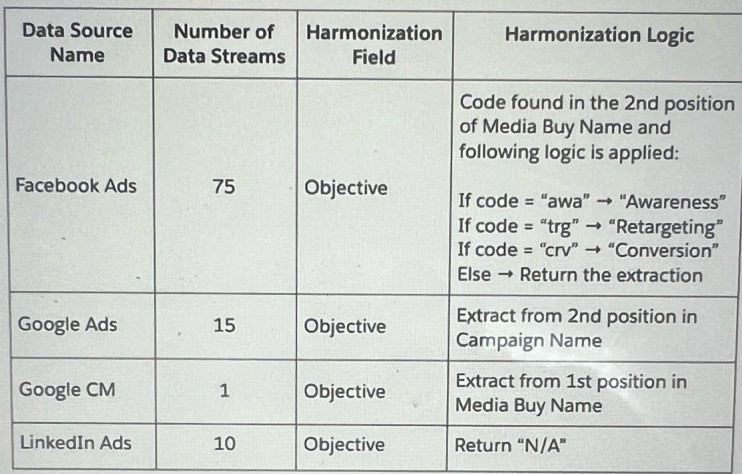
Which three advantages does a client gain from using Calculated Dimensions as the harmonization method for creating the Objective field?
A. Scalability - future data streams that will follow similar logic will be automatically harmonized.
B. Data model restrictions - Calculated Dimensions do not need to adhere to Marketing Cloud Intelligence's data model
C. Processing - creation of Calculated Dimensions will ease the processing time of the data streams it relates to
D. Ease of Maintenance - the logic is written and populated in one centralized place
E. Performance (Performance when loading a dashboard page) should be optimized as the values of calculated dimensions are stored within the database.
Explanation:
Using Calculated Dimensions as the harmonization method for creating the 'Objective' field in Marketing Cloud Intelligence offers several advantages, particularly for a client integrating multiple data sources (Facebook Ads, Google Ads, Google CM, LinkedIn Ads) with varying logic.
A. Scalability - future data streams that will follow similar logic will be automatically harmonized:
This is correct. Calculated Dimensions allow the client to define a reusable formula (e.g., extracting and mapping codes to "Awareness," "Retargeting," or "Conversion" for Facebook Ads, or positions for other sources). Future data streams adhering to the same logic can be automatically harmonized without manual reconfiguration, enhancing scalability.
D. Ease of Maintenance - the logic is written and populated in one centralized place:
This is correct. The harmonization logic (e.g., conditional statements for Facebook Ads or position extractions for Google Ads) is defined centrally within the Calculated Dimensions feature, making it easier to update or maintain across all data streams (75 for Facebook Ads, 15 for Google Ads, etc.) without altering individual source mappings.
E. Performance (Performance when loading a dashboard page) should be optimized as the values of calculated dimensions are stored within the database:
This is correct. Calculated Dimensions precompute and store values in the database, reducing the need for real-time calculations when loading dashboards, thus improving performance across the 101 total data streams.
B. Data model restrictions - Calculated Dimensions do not need to adhere to Marketing Cloud Intelligence's data model:
This is incorrect. Calculated Dimensions must align with the data model’s structure and rules, as they are built on existing dimensions and fields, not exempt from them.
C. Processing - creation of Calculated Dimensions will ease the processing time of the data streams it relates to:
This is incorrect. While Calculated Dimensions simplify logic application, they may increase initial processing time due to the computation involved, rather than easing it.
Reference:
This aligns with Salesforce Marketing Cloud Intelligence’s documentation on Calculated Dimensions, which emphasizes scalability, centralized maintenance, and performance benefits.
A client's data consists of three data streams as follows:
Data Stream A:
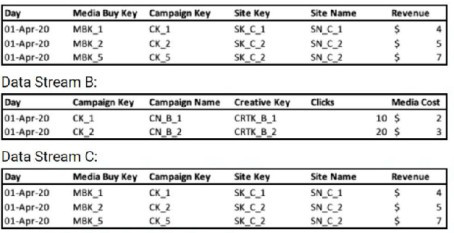
* The data streams should be linked together through a parent-child relationship.
* Out of the three data streams, Data Stream C is considered the source of truth for both the dimensions and measurements.
How should the "Override Media Buy Hierarchies” checkbox be set in order to meet the client's requirements?
A. It should be checked in Data Stream C
B. It should not be checked in any of the three Data Streams.
C. It should be checked in Data Stream B
D. It should be checked in Data Stream A
Explanation:
The client has two key requirements:
Data Stream C is the source of truth for both dimensions and measurements.
The data streams should be linked through a parent-child relationship.
The "Override Media Buy Hierarchies" checkbox is a powerful setting that dictates which data stream provides the authoritative definition of the Media Buy hierarchy (i.e., the relationship between Media Buy Key, Campaign Key, and other related dimensions).
Why A is Correct:
By checking "Override Media Buy Hierarchies" in Data Stream C, you are explicitly telling the platform to use the dimensions (like Media Buy Key, Campaign Key, Site Key, Site Name) from Data Stream C as the master definitions for the entire data model. This ensures that the hierarchical structure and dimension values from the designated "source of truth" are used to organize and link the data from all other streams (A and B). This action fulfills both requirements: it establishes C as the source of truth and is the necessary step to correctly form the parent-child relationships based on that truth.
Why the Other Options are Incorrect:
B. It should not be checked in any of the three Data Streams:
If this box is not checked in any stream, the platform will not know which stream to use as the master for the Media Buy hierarchy. This would likely lead to a default behavior that does not respect the requirement that Data Stream C is the source of truth, potentially causing data duplication or misalignment.
C. It should be checked in Data Stream B:
Data Stream B is not the source of truth. It contains different dimensions (Creative Key, Campaign Name) and lacks the Site Key and Site Name dimensions present in A and C. Making B the hierarchy master would ignore the client's explicit requirement and result in an incorrect data model.
D. It should be checked in Data Stream A:
While Data Stream A has the same structure as C, the client has specifically stated that Data Stream C is the source of truth. Therefore, C must be chosen as the master hierarchy stream to ensure consistency and accuracy.
Reference:
This aligns with the MCI data modeling principle of using a single, authoritative source for dimensions to build accurate and non-duplicative relationships across multiple data streams. The "Override" checkbox is the primary tool for defining this authoritative source.
A client's data consists of three data streams as follows:
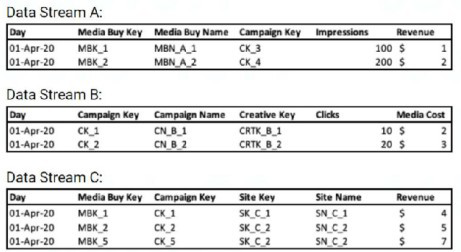
* The data streams should be linked together through a parent-child relationship.
* Out of the three data streams, Data Stream C is considered the source of truth for both the dimensions and measurements.
* Data Stream C was set as a ‘Parent’, and the ‘Override Media Buy Hierarchy’ checkbox is checked
What should the Data Updates Permissions be set to for Data Stream B?
A. There is no difference, all permissions will have a similar effect given the scenario.
B. Update Attributes and Hierarchies
C. Update Attributes
D. Inherit Attributes and Hierarchies
Explanation:
When a data stream is designated as a 'Parent' with the 'Override Media Buy Hierarchies' checkbox checked, it becomes the source of truth for all dimensional data linked to the Media Buy entity. The Data Updates Permissions setting for its child data streams then determines how they interact with the parent's data.
Since Data Stream B is a child to Data Stream C (the source of truth), it must be configured to inherit its dimensional information from the parent. This ensures that any attributes (e.g., Media Buy Name, Campaign Name) and hierarchies from Data Stream C are applied to Data Stream B's data, maintaining consistency across the data model.
Update Attributes and Hierarchies (Incorrect): Selecting this would cause Data Stream B to push its own dimensional data up the hierarchy, which would conflict with the 'Override' setting on Data Stream C and violate the client's requirement that C is the source of truth.
Update Attributes (Incorrect): This would also allow Data Stream B to update some of its dimensional data, which is not the intended behavior.
There is no difference, all permissions will have a similar effect given the scenario (Incorrect): The permissions have a significant impact on how data is managed in the parent-child relationship. Setting them incorrectly would lead to data inconsistencies and reporting errors.
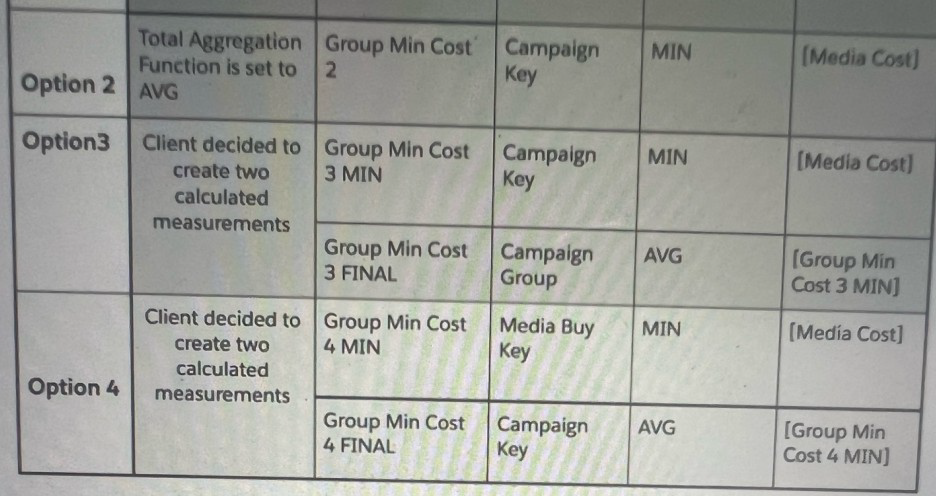
Which option will yield the desired result:?
A. Option 1
B. Option 4
C. Option 2
D. Option 3
Explanation:
The client's goal is to create a final calculated measurement, likely for a Media Cost, by first finding a minimum value at a specific level and then aggregating that minimum value. Let's break down the logic for each option:
Option 1:
The provided image does not include an "Option 1."
Option 2:
This option sets the "Total Aggregation Function" to AVG and groups by a "Group Min Cost." This is an incorrect approach as it averages a pre-aggregated value, which may not be the desired outcome. The logic is incomplete, so it's impossible to determine if it meets the requirements.
Option 3:
This option creates a calculated measurement called Group Min Cost 3 MIN using MIN aggregation on [Media Cost] grouped by Campaign Key. This is a valid first step. However, the second calculated measurement, Group Min Cost 3 FINAL, takes the AVG of the Group Min Cost 3 MIN and groups it by Campaign Group. This does not match the desired logic of grouping at the Media Buy Key level as seen in Option 4, which is typically a more granular level of a campaign hierarchy.
Option 4:
This option correctly outlines a two-step process to achieve the desired result.
First Calculated Measurement: Group Min Cost 4 MIN is created using the MIN aggregation of [Media Cost], grouped by the Media Buy Key. This is a logical first step to get the lowest cost for each specific media buy.
Second Calculated Measurement: Group Min Cost 4 FINAL then takes the AVG of [Group Min Cost 4 MIN] and groups it by the Campaign Key. This correctly aggregates the minimum media buy costs to the campaign level, which is a common reporting need.
The logic in Option 4 directly addresses a common scenario in marketing analytics: finding the minimum cost at a lower level of a hierarchy (Media Buy Key) and then averaging or summing those minimums at a higher level (Campaign Key). This two-step process is the standard way to handle these types of aggregations in Marketing Cloud Intelligence, making it the most likely correct option.
| Page 1 out of 7 Pages |
Our new timed Marketing-Cloud-Intelligence practice test mirrors the exact format, number of questions, and time limit of the official exam.
The #1 challenge isn't just knowing the material; it's managing the clock. Our new simulation builds your speed and stamina.
You've studied the concepts. You've learned the material. But are you truly prepared for the pressure of the real Marketing Cloud Intelligence Accredited Professional exam?
We've launched a brand-new, timed Marketing-Cloud-Intelligence practice exam that perfectly mirrors the official exam:
✅ Same Number of Questions
✅ Same Time Limit
✅ Same Exam Feel
✅ Unique Exam Every Time
This isn't just another Marketing-Cloud-Intelligence practice questions bank. It's your ultimate preparation engine.
Enroll now and gain the unbeatable advantage of: